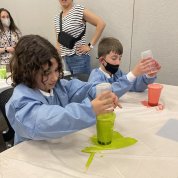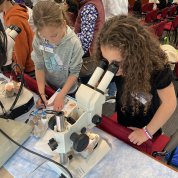Day of Discovery
NIH’s Take Your Child to Work Event Celebrates 30th Year

Photo: Anna Conrey/NHLBI
Lots of folks might be grossed out by blood, brains and bacteria, but the throngs of curious kids who accompanied their grown-ups to Take Your Child to Work Day (TYCTWD) were eager to experience these wonders, and many got an up-close look.
On Apr. 25, more than 3,700 children participated in more than 350 different in-person, hands-on activities as well as virtual and pre-recorded sessions. Children in grades 1-12 conducted all kinds of science experiments, marveled at cool demonstrations, toured labs and facilities, participated in educational games and got all goopy doing art. Swarms of youngsters and grown-ups also stopped by Earth Day exhibits outside of Bldg. 1.
Each year, the Clinical Center (CC) is abuzz with many TYCTWD activities. An annual favorite, Clinical Lab Experience lets kids get up close with blood, bacteria and parasites. At stations around the room, children peered through microscopes at ticks and lice; at petri dishes of staph, strep and other bacteria; and at cholesterol and neutrophils in blood cells.

Photo: Chia-Chi Charlie Chang
“It all starts with the blood,” said Michael Guyah, a technician in the CC’s department of laboratory medicine, demonstrating how a phlebotomist collects blood.
One floor up, kids inflated preserved pig lungs, including one blackened by tobacco, in a session hosted by the National Heart, Lung and Blood Institute. Across the room, young people blew air into a tube to assess pulmonary function.
“We wanted the kids to appreciate a visual of how much air moves in and out of their chests with a single breath by capturing it in a plastic bag,” said Dr. Amisha Barochia, NHLBI staff clinician.

Photo: Chia-Chi Charlie Chang
Barochia also led a simulation to show how a pulmonologist would assess, navigate and sample affected parts of the lung. “We wanted the kids to have a go at manipulating the bronchoscope through a model of the airways,” she said.
Over in the Audiology Clinic, a lab tech spun around in a rotary chair to show how balance is connected to the eyes and ears. Dr. Chris Zalewski, an audiologist with the National Institute on Deafness and Other Communication Disorders, told the wide-eyed young participants, “If someone doesn’t have a vestibular system, their eyes can’t move.”
Children on that tour also visited a series of soundproof booths, where they tested each other’s hearing and saw real-time graphs of how the eardrum moves in response to sound.

Photo: Chia-Chi Charlie Chang
Outside, on the crisp spring day, various open events with no space limit kept kids engaged, from police K-9 demonstrations to outdoor fitness challenges to a walking tour of the NIH stream.
At the Earth Day event—which NIH traditionally holds simultaneously with TYCTWD—exhibits taught about pollution dangers, lab safety, recycling, composting and other ways to protect the planet. By far the biggest crowds gathered around the reptile rescue, which featured a Gila monster (the venomous lizard fully enclosed in his tank), box turtles and several kinds of snakes. Kids especially loved petting the star attraction, a three-year-old alligator named Spike.
“It was an amazing day! We loved every second of it,” said one mom whose young son especially enjoyed visiting the NIH fire station. “When I told him we had to take a shuttle, he asked if we were going into space,” she said with a laugh.
Who knows where the day’s memories will one day take these kids? The sky’s the limit.
























